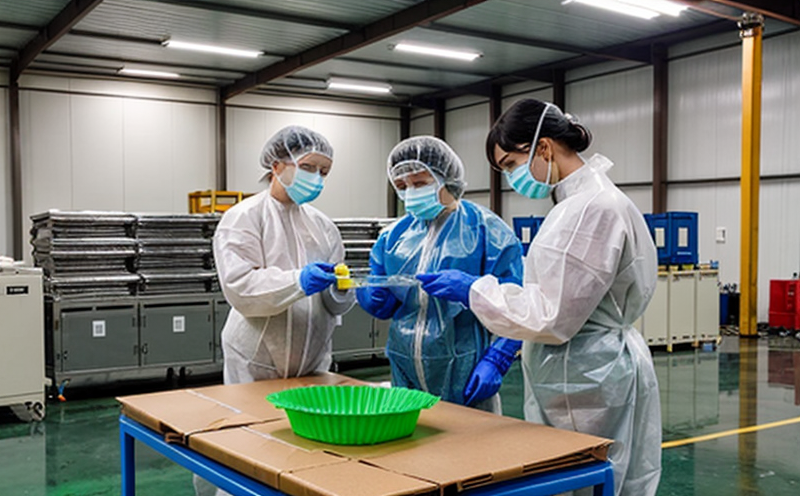ISO 2556-2 Burst Pressure Testing
The ISO 2556-2 Burst Pressure Test is a critical procedure used in the quality assurance and compliance of plastic packaging. This test evaluates the burst strength of packaging materials, ensuring they can withstand internal pressure without failure. The test is particularly relevant for containers that are subjected to pressurized contents, such as bottles or pouches.
The burst pressure test involves subjecting a specimen to an increasing internal pressure until it fails. This method assesses the ability of the packaging material to resist mechanical forces and ensure product integrity. Understanding the bursting behavior is vital for ensuring that packages can maintain their structural integrity under various conditions, which includes handling, shipping, and storage.
The test is conducted in accordance with ISO 2556-2:1990 (reconfirmed as of 2018), which provides a standardized approach. The procedure involves several key steps:
- Preparation of the specimen according to the specified dimensions and thickness.
- Clamping the specimen in a pressure chamber.
- Increasing the internal pressure gradually while monitoring the specimen's response.
- Recording the point at which failure occurs, measured as the burst pressure.
The test is essential for ensuring that packaging materials meet the required standards and specifications. By subjecting plastic packaging to this rigorous testing, manufacturers can identify any weaknesses in their design or material selection early on. This proactive approach helps prevent costly recalls and ensures customer satisfaction by delivering products in undamaged containers.
The results of the burst pressure test are used to inform decisions about material type, thickness, and overall package design. For instance, if a particular plastic is found to have insufficient burst strength, manufacturers may opt for an alternative polymer or increase the wall thickness of the container. This testing ensures that the final product not only meets but exceeds industry expectations in terms of durability.
Understanding the real-world implications of this test helps ensure that packaging materials are not just laboratory standards but also practical solutions for various applications. For instance, in the pharmaceutical sector, where product integrity is paramount, burst pressure testing ensures that medications remain protected during transit and storage.
In summary, ISO 2556-2 Burst Pressure Testing is a cornerstone of quality assurance in plastic packaging manufacturing. It provides critical insights into the performance characteristics of materials used in packaging applications. This test helps ensure product integrity, enhances customer satisfaction, and supports regulatory compliance across industries.
Applied Standards
| Standard | Description |
|---|---|
| ISO 2556-2:1990 (reconfirmed as of 2018) | This standard specifies the method for determining the burst pressure of plastic containers. It is applicable to packaging materials such as bottles, pouches, and other rigid plastic containers. |
Customer Impact and Satisfaction
The ISO 2556-2 Burst Pressure Test significantly impacts customers by ensuring that packaging materials are robust enough to withstand the rigors of transport, storage, and use. By conducting this test, manufacturers can guarantee that their products arrive at the destination in perfect condition, thus enhancing customer satisfaction.
For instance, a retailer dealing with perishable goods relies heavily on packaging integrity to maintain freshness and quality. A strong burst pressure rating ensures that the goods remain protected throughout transit, minimizing spoilage and ensuring product quality at the point of sale. This translates directly into increased customer trust and loyalty.
The test also contributes to regulatory compliance by ensuring that packaging materials meet stringent industry standards. Compliance with these standards is crucial for manufacturers who operate in regulated industries such as food, pharmaceuticals, and medical devices. Meeting these requirements not only avoids legal penalties but also enhances the reputation of the brand in the eyes of consumers.
Furthermore, the test plays a critical role in R&D efforts by providing valuable data that can be used to improve packaging designs. This continuous improvement cycle ensures that products are not just compliant with current standards but are also competitive and innovative in the market.
International Acceptance and Recognition
The ISO 2556-2 Burst Pressure Test is widely recognized and accepted across international borders. Its universal applicability makes it a cornerstone of quality assurance in plastic packaging manufacturing globally.
Countries with varying regulatory frameworks and industry standards rely on this test to ensure that their domestic and imported products meet the necessary durability requirements. The standardized approach provided by ISO ensures consistency, enabling seamless trade across different markets.
Manufacturers who adhere to these international standards benefit from greater market access and enhanced credibility among both local and global buyers. This recognition also aids in building strong relationships with suppliers and customers worldwide, fostering a collaborative environment that drives innovation and quality.





